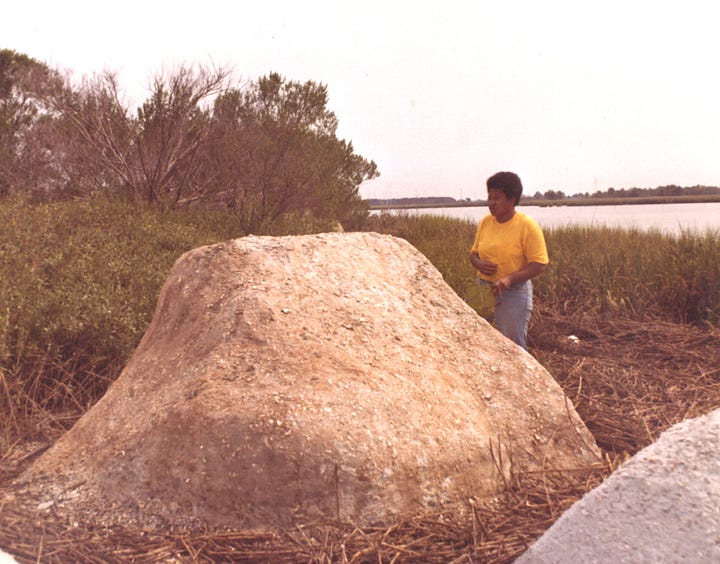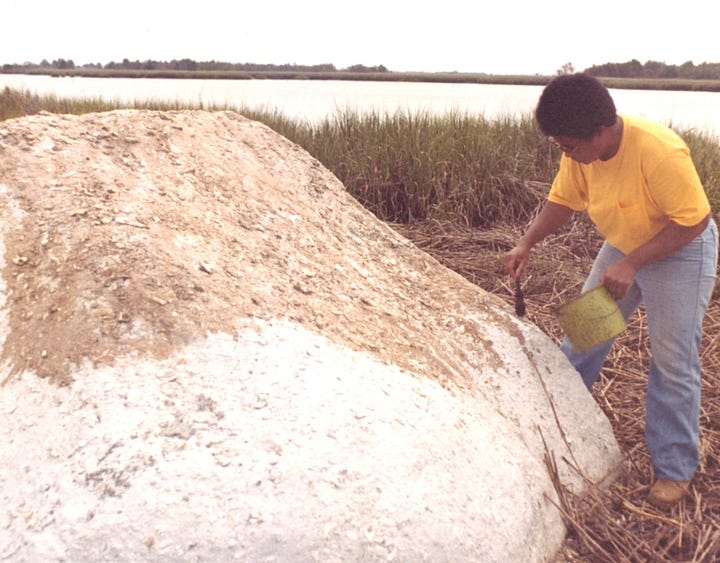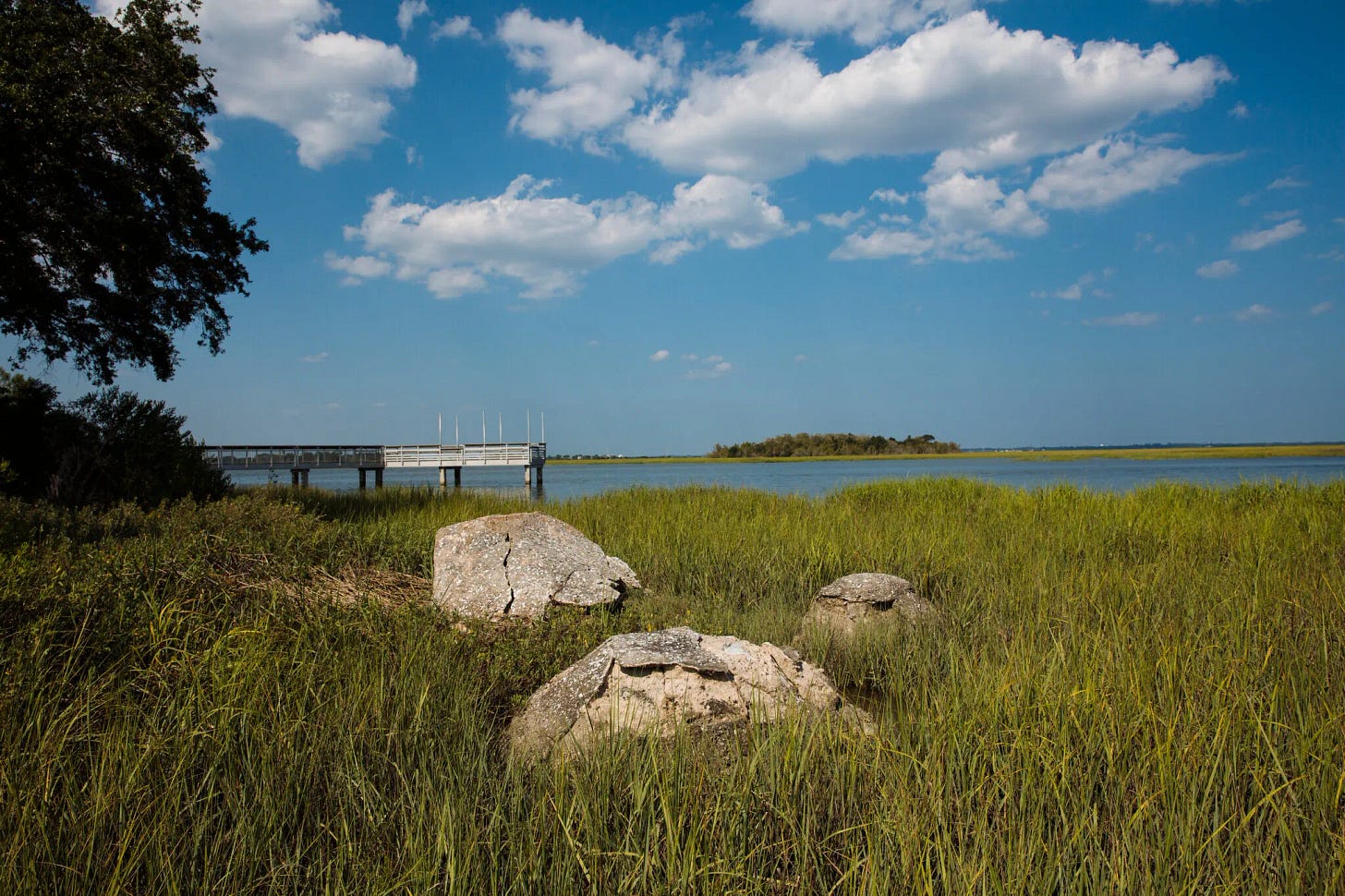A trip to Marsh Ruins
Buchanan's masterwork, which sits about an hour south of Savannah, is slipping into the Marsh.
I recently drove my brother-in-law down to Tampa to pick up a little truck he’d bought. Our route south from Savannah took us through Brunswick–a town of 15,000 on the southeast coast of Georgia. On a stretch of Highway 17 that runs alongside the Marshes of Glynn in Brunswick sits Beverly Buchanan’s Marsh Ruins, three concrete and tabby mounds slowly sinking into the wetland.
If you don’t know what to look for, you will miss them. Similar shell and stone masses sit in the marsh along the highway, likely remnants of old docks or buildings. There is no sign or marker for the sculptures, save a small piece of tabby tucked into the brush on the roadside that Buchanan signed, pointing to their existence (which I didn’t learn about until doing some digging online later).
Many consider the monolithic sculptures to be Buchanan’s masterwork. She installed the formations in 1981 with funding from a Guggenheim fellowship and the help of a local contractor. The artists visited the work throughout her life, photographing its continual evolution or taking long periods to sit quietly amongst the three forms. Despite Buchanan’s affection for the piece, she left no instructions for preserving the work when she passed in 2015. They continue to crack and erode, becoming part of the muck beneath them.


To view the Marsh Ruins up close, you must wade into the tidal bed and through the surrounding cordgrass. Small marsh crabs scurry across the mud and into their holes as your feet sink into the earth. The three sculptures look inward toward one another, holding vigil for some mystery beyond you. Walking between and around the forms, I felt like an observer, not a participant. I was passing through. They would be here forever.
From what I’ve read, Buchanan gave no hint towards the work's intent. Throughout the late 70s and early 80s, Buchanan created several sculptural markers of Black memory throughout Georgia (where she lived at the time, first Macon, then Athens.), so we might assume these sculptures hold a similar aim. The Marsh Ruins in Brunswick are thought to be a tribute to the victims of a mass suicide of enslaved Igbo peoples, who drowned themselves in the nearby marshes while being transported from Savannah to a plantation in St. Simons. The story was powerful Galluh folklore: men and women wading into the wetlands, claiming a path for themselves, even if the path was devastating. In some tellings, the victims ascend rather than sink into the wetland. Buchanan’s partner confirmed that she knew the story well, saying Buchanan had been enraged when she learned there was no marker paying tribute to the victims. (A marker was erected in St. Simons in 2022, more than 40 years after Buchanan constructed Marsh Ruins.) When creating the work, it’s said that Buchanan did not refer to the Igbo Massacre; however, the proximity of the massacre’s site and her partner link the work to the memory of the victims. Similar tabby mounds mark graves across the coastal South. Buchanan trains our eyes to find these other often-forgotten markers.
When I visited the Marsh Ruins, I knew little about them. Beyond their existence and when they were created–I had no prior knowledge to guide how I responded to them. I left thinking about the way our surroundings shape us. Time and place have a potential for erosion, breaking down the outer layers to reveal what is essential. The tabby exterior of Buchanan’s forms has cracked and chipped away, revealing the concrete shapes beneath. I started to think about their willingness to disappear into the landscape, their willingness to change, and Buchanan’s own willingness to let her masterwork sink into the earth beneath. The cycle is not resisted. Their name, “Marsh Ruins,” foretells their end. I imagined Buchanan returning to see her changing forms, constantly shifting year after year. I wondered if she grieved their fractured outer shells or welcomed their ruin, seeing them off as they slowly returned to the mud below.

More information on the Marsh Ruins
How to get there:
Route yourself to 1420 Glynn Ave, Brunswick, GA 31520. Marshes of Glynn Overlook Park is just up Highway 17, and there is parking. Once you park, the Ruins are a short walk down the highway to your right when facing the water. The Marsh Ruins are about an hour and twenty-minute drive from Savannah and five hours from Atlanta.
The Marsh Ruins connection to the poem “The Marshes of Glynn”:
Confederate veteran and poet Sidney Lanier wrote the poem “The Marshes of Glynn” under a tree about a half-mile from the Marsh Ruins. A historical marker is beneath the tree where Lanier is thought to have written the poem. Buchanan’s sculpture stands between the marked site of the poem’s origin and the site of the Igbo massacre (unmarked until 2022). The historical treatment of the three sites offers an insightful look into the things we memorialize and those we forget. An article from the NYT about Buchanan’s sculpture digs into the relationship between the three sites in more depth; you can read it here.
Further reading on Beverly Buchanan’s Marsh Ruins:
A Vanishing Masterpiece in the Georgia Marshes, Siddhartha Mitter for the NYT
A short write-up in Art Papers about the sculptures
Art Historian Amelia Groom’s book about Marsh Ruins
A deeper dive into Beverly Buchanan’s work via Rhyzomes
Some news
Things in the gallery are taking shape, and construction is starting to wind down. The floors went in last week! I will share more about the process of building the gallery soon. It’s been a communal effort, and I feel so grateful for the help of some dear friends and my parents to get it across the finish line.
Summer movie nights are underway! You can follow along on Instagram to hear when things are happening.
Our first exhibition is set to open this September! I’ll share more details soon - stay tuned :)





